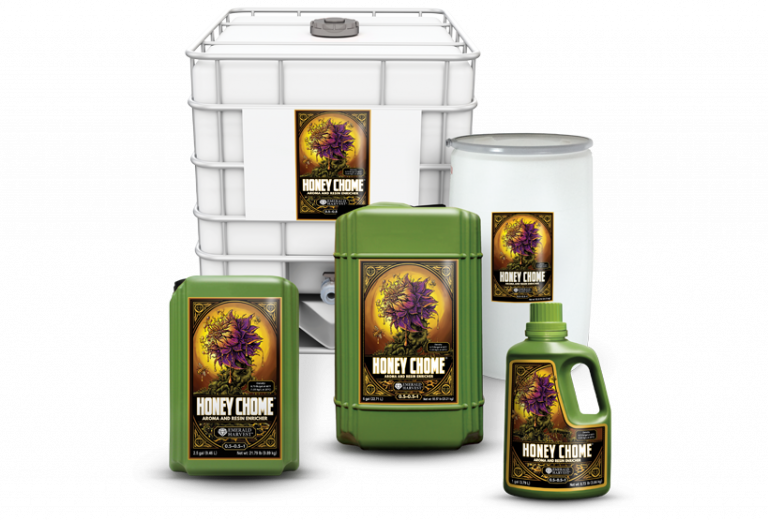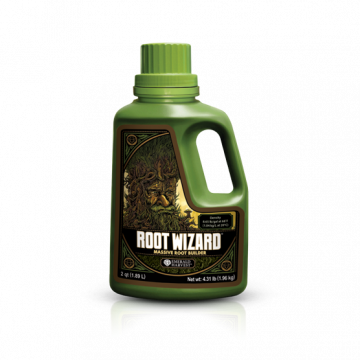HONEY CHOME
1.
WHAT IS HONEY CHOME?

Honey Chome is a carbohydrate-rich supplement that increases production of sweet, sticky trichomes and terpene rich, essential oils while feeding the beneficial microbes in the root zone. Honey Chome enhances what your customers want most—fragrance, flavor, color and potency.
2.
WHAT DOES HONEY CHOME DO?
Honey Chome is formulated to encourage terpenes, esters and phenols – compounds responsible for all the things growers prize most. Higher terpenes means more flavor, color, aroma and potency.
- Enhances sticky trichomes
- Elevates essential oils
- Increases potency
- Strengthens fragrance
- Enriches colors
- Improves taste
In addition, Honey Chome provides a ready source of energy to the plant through the roots, the carbohydrates in Honey Chome feed the beneficial microorganisms in the plant’s root zone ensuring their colonies get well established, proliferate and thrive.
Honey Chome is designed to work in tandem with Emerald Harvest Root Wizard!

3.
WHY PURCHASE HONEY CHOME
OVER ANOTHER BRAND?
Honey Chome is made from 95% organic ingredients. It uses natural carbohydrates and other special, natural ingredients in the formulation to help plants develop high percentage oils as well as extremely potent aromas and flavors.
Honey Chome does this without changing the terpene profile – it enhances it. Honey Chome, like the rest of the Emerald Harvest line, enhances the plant’s natural attributes – it does not mask them or override them like some products can.
For growers who want their plants to be their absolute natural best – Honey Chome is the best choice.
4.
HOW DOES HONEY CHOME WORK?
1. Honey Chome blends carbohydrates in just the right amounts to sustain a thriving rhizomicrobial ecosystem (root zone) and enhance crop quality.
a) Honey Chome’s carbohydrates are derived from sugar cane, palm sugar and agave nectar – these carbs are easy for the plant to break down and utilize.
b) Some growers use molasses – molasses can do the job, but the challenge is determining the right quantity. If you feed too many carbs to the roots, you aren’t just going to support the beneficial microbes. You might also inadvertently supply more than they can eat, attracting harmful microbes and encouraging them to flourish in the root zone.
c) You don’t have to worry about overfeeding with Honey Chome. Its sugars are supplied in precisely the right concentrations—no more, no less.
- Faster rates of microbial propagation
- Stronger microbial communities
- More vibrant microbial ecosystem
2. Honey Chome contains magnesium for photosynthesis and sugar translocation.
This is based on our scientific team’s hypothesis that crops take up supplemental carbs:
a) at nighttime, when photosynthesis ceases and lots of energy must be expended by the roots to break down starch into glucose
b) when crops aren’t photosynthesizing optimally, such as when cuttings are rooting or when the leaves are diseased. Carbohydrate supplementation might even save a compromised harvest.
3. Additional nitrogen, phosphorus and potassium for peak bud production.
4. Honey Chome’s unique formulation encourages the production of terpenes:
Terpenes are the building blocks of resins and saps. They directly relate to cannabis quality:
- The more terpenes, the better the fragrance of flowers.
- The more terpenes, the better the flavor of fruits.
- The more terpenes, the stronger the medicine!
5.
CAN I USE HONEY CHOME
WITH MY CURRENT NUTRIENT LINE?
Yes, you can! Though the Emerald Harvest line of premium nutrients works together like the pieces in a perfect puzzle, you can also safely use Honey Chome with other nutrient lines – especially to enhance the terpene quality or to nourish the root zone.


